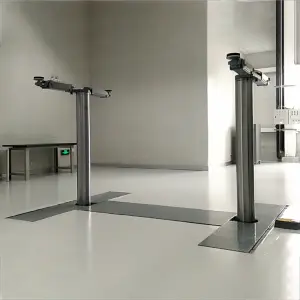In the automotive world, precision and efficiency can make or break a job. Whether you are a mechanic running an auto repair shop or a car enthusiast who enjoys working on your vehicles, having the right tools and equipment is critical. One of the most transformative pieces of equipment that has changed the landscape of vehicle maintenance is the inground lift. This article will delve into what inground lifts are, their benefits, installation considerations, and maintenance tips to help you decide whether this investment is right for your garage.
What is an Inground Lift?
An inground lift is a type of vehicle lifting system that is installed below ground level. Unlike traditional above-ground lifts that occupy space above the garage floor, inground lifts are recessed into the ground, providing a clear workspace above. This design offers a range of benefits, including ease of access, more available garage space, and a streamlined aesthetic.
Inground lifts come in various types, including hydraulic and pneumatic models. Hydraulic inground lifts use fluid to operate, providing a smooth lifting mechanism, while pneumatic lifts rely on compressed air. The choice between hydraulic and pneumatic often depends on individual needs and space constraints.
Benefits of Inground Lifts
1. **Space Efficiency**: One of the most significant advantages of an inground lift is the space-saving aspect. With the lift being recessed, there is no bulky equipment obstructing the garage area. This allows for a more organized work environment, especially in smaller garages.

The Ultimate Guide to Inground Lifts: Revolutionizing Vehicle Maintenance and Enhancing Garage Efficiency for Car Enthusiasts and Professionals
2. **Enhanced Accessibility**: Inground lifts are designed for ease of access to the undercarriage of vehicles. Mechanics can work on the vehicle comfortably without awkward positions, its lower profile enabling seamless access to all parts.
3. **Improved Safety**: Safety is paramount in any workspace. Inground lifts offer a reduced risk of accidents, thanks to stable hydraulic systems that minimize the chance of drop malfunctions. They also remove tripping hazards often found with above-ground systems.

The Ultimate Guide to Inground Lifts: Revolutionizing Vehicle Maintenance and Enhancing Garage Efficiency for Car Enthusiasts and Professionals
4. **Increased Property Value**: Installing an inground lift can enhance the property value of your garage. A sophisticated lift system may be an attractive feature for potential buyers, especially those interested in automotive repairs or modifications.
5. **Professional Appearance**: For commercial workshops, an inground lift provides a polished and professional look. Customers visiting your shop will appreciate a well-organized workspace, enhancing customer confidence in your services.
Installation Considerations
Installing an inground lift is a significant investment, both in terms of financial outlay and physical space. It’s essential to consider several factors before proceeding with installation:
1. **Space Requirements**: Ensure that your garage has sufficient depth and width to accommodate the lift installation below ground. Most inground lifts require a pit, which means a significant amount of concrete must be excavated.
2. **Permits and Regulations**: Check local building codes and regulations regarding lift installations. Some areas may require permits, so it’s best to consult local authorities before starting the process.
3. **Professional Installation**: Due to the complexity and safety considerations, hiring a professional for the installation is highly recommended. Certified technicians will ensure that the lift is installed correctly and safely.
4. **Budget**: The cost of inground lifts varies greatly based on brand and features. Set a budget that incorporates not only the lift but also installation and potential future maintenance.

The Ultimate Guide to Inground Lifts: Revolutionizing Vehicle Maintenance and Enhancing Garage Efficiency for Car Enthusiasts and Professionals
Maintenance Tips for Inground Lifts
Once installed, maintaining your inground lift is key to ensuring its longevity and reliability:
1. **Regular Inspections**: Routinely check the mechanical parts, hydraulic fluid levels, and electrical systems. Identifying issues early can prevent costly repairs down the line.
2. **Clean the Pit**: Debris can accumulate in the pit area, so regular cleaning is necessary to ensure smooth operation. Keeping the area clean also enhances safety.
3. **Hydraulic Fluid Maintenance**: Verify the condition of hydraulic fluid regularly and replace it as needed to ensure the lift operates smoothly and efficiently.
4. **Follow Manufacturer Guidelines**: Each manufacturer provides guidelines regarding maintenance schedules and operational limits. Always follow these to maintain warranty coverage and optimal performance.
Conclusion
Investing in an inground lift can significantly enhance your vehicle maintenance capabilities, offering both convenience and efficiency. Whether for personal use or a commercial garage, these lifts elevate the standard of vehicle service and maintenance. By understanding the benefits, installation requirements, and maintenance needs, you can make an informed decision about whether an inground lift is the perfect addition to your automotive workspace.quick lift car lift
